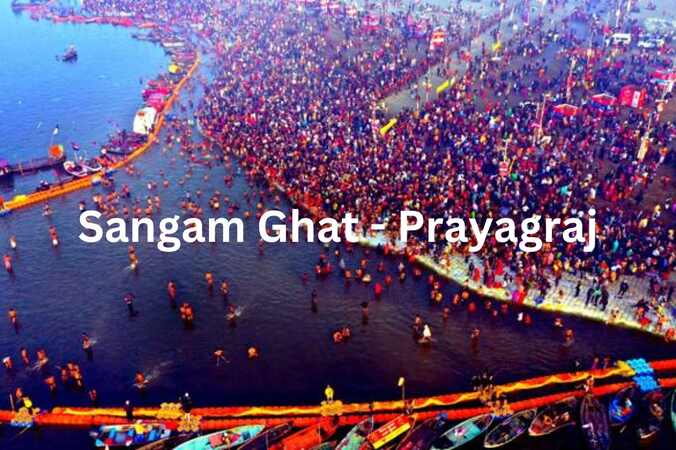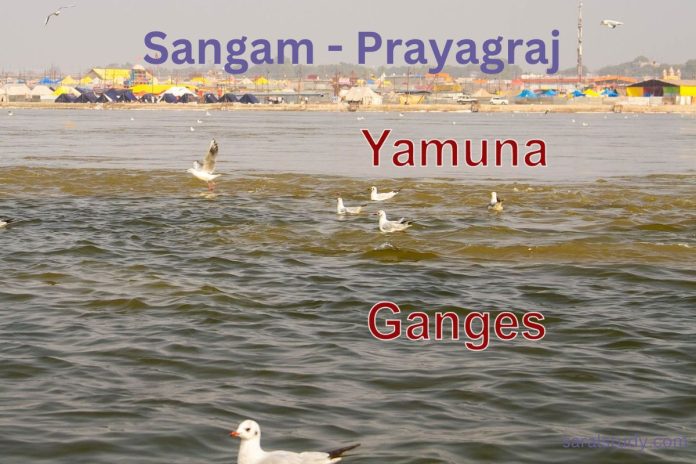Prayagraj, formerly known as Allahabad, is a city of historical and religious importance in the Indian state of Uttar Pradesh. It is called Tirtharaj (King of Pilgrimages) in Hinduism, as it is located at the holy confluence of the rivers Ganga, Yamuna and the invisible Saraswati. Prayagraj is not only important from a spiritual point of view, but it also has a rich historical and cultural significance.
Ancient History of Prayagraj
Prayagraj is mentioned in the Rigveda, Mahabharata, Ramayana and Puranas. It was called Prayag, which means “land of sacrifices“. According to Hindu scriptures, Brahma ji performed yajna here before the creation of the universe, making this place extremely sacred.
During the Mahabharata period, the Pandavas came to Prayagraj during their exile and bathed in the Sangam here. In the Gupta period (4th-6th century) this area became a major center of knowledge and cultural activities.
During the Mughal period, this area gained special importance and came to be known by a new name.
How did Prayagraj get the name “Allahabad”?
In 1583, the Mughal emperor Akbar built a new fort in the sacred area of Prayag and named it Ilahabas, which means “place of Allah”. Later, this name became Allahabad.
Akbar made it an important center from administrative and military point of view, and Allahabad thereafter developed as a major settlement of the Mughal Empire.
Allahabad also gained special importance during the British rule. In 1858, the Government of India Act was announced here, which strengthened the British rule. Apart from this, Allahabad also played a major role in the Indian freedom struggle.
Restoration of the name Prayagraj
In 2018, the Uttar Pradesh government renamed this historic city as Prayagraj. The main reason behind this name change was that Prayagraj has originally been a center of Hindu religious faith, and “Prayag” has been mentioned in Hindu texts for thousands of years.
The government argued that the name “Allahabad” given by Akbar was intended to change the ancient and religious identity of the region. Therefore, its historical and cultural identity was restored by renaming it Prayagraj.
Sangam: The meeting place of three holy rivers
The Triveni Sangam located in Prayagraj is a very holy place in Hinduism, where the rivers Ganga, Yamuna and the invisible Saraswati meet. This place is considered very important from religious, spiritual and cultural point of view. Ganga is known for its cleanliness and fast flow, the water of Yamuna is relatively calm and deep, while the Saraswati river is believed to flow here invisibly.

It is believed that bathing in the Sangam destroys sins and leads to salvation. Crores of devotees take a dip here during the Kumbh and Ardh Kumbh fairs. Apart from this, many sages and saints had performed penance in the Sangam area, making this place even more divine and important.
Prayagraj and Kumbh Mela
Prayagraj is world famous for the Kumbh Mela. Once every 144 years, Maha Kumbh is organized here, in which crores of devotees come to take bath in Sangam. According to Hindu belief, bathing in Kumbh Mela leads to salvation.
The Kumbh Mela held in Prayagraj in 2019 was also recognized by the United Nations (UNESCO) as a cultural heritage.
Maha Kumbh 2025: World’s largest spiritual event
Mahakumbh 2025 is being held in Prayagraj from January 14 (Makar Sankranti) to February 26 (Mahashivratri), in which ~40 crores of devotees are expected to take holy bath in the confluence of Ganga, Yamuna and invisible Saraswati. This festival Mahakumbh, held every 144 years, is the biggest religious and cultural event of Hinduism, in which sanyasis, Aghoris, Naga Sadhus, saints and devotees gather.
Shahi Snan, religious rituals, spiritual discourses and cultural programs are its features. It is believed that bathing in the confluence during this time leads to salvation. Special preparations are being made regarding security, cleanliness and traffic management so that devotees can participate in this mega event without any hindrance.
World records in Mahakumbh 2025
- Several important records have been set in Mahakumbh 2025. On the occasion of Makar Sankranti (14th January 2025), about 4 crore devotees took a dip in the Sangam in a single day, which is a new record. Source: etvbharat.com
- Additionally, four Guinness World Records were set during Mahakumbh: the largest e-rickshaw parade, the largest river cleaning drive, the most handprint paintings in eight hours, and the largest coordinated cleaning drive.source: timesnowhindi.com
- On the day of Mauni Amavasya (29 January 2025), Mahakumbh Nagar became the largest temporary city in the world, where more than 8 crore devotees took a dip in the Sangam. source: moneycontrol.com
These achievements have made Mahakumbh 2025 historic.
Importance of Kumbh Mela
According to Hinduism, when the Amrit Kalash came out during the churning of the ocean between the gods and the demons, some of its drops also fell in the Sangam of Prayagraj. For this reason, Kumbh Mela is organized on the banks of Sangam.
Kumbh Mela is held in four holy cities—Prayagraj, Haridwar, Ujjain and Nashik. It is held at different intervals:
- Prayagraj (Allahabad) – Triveni Sangam
Mahakumbh every 12 years, Ardh Kumbh every 6 years - Haridwar – Ganges bank
Kumbh Mela every 12 years - Ujjain – Shipra river bank
Simhastha Kumbh every 12 years - Nashik – Godavari river bank
Kumbh Mela every 12 years
Special events:
- Mahakumbh is held only in Prayagraj every 144 years (12 Kumbh cycles).
- Ardh Kumbh is held only in Prayagraj and Haridwar every 6 years.
- Simhastha Kumbh is held only in Ujjain.
These fairs are held based on the special position of the planets and constellations and have special spiritual and cultural significance in Hinduism.
Prayagraj: A religious and cultural pilgrimage place
- Triveni Sangam: The meeting place of Ganga, Yamuna and the invisible Saraswati, which is one of the holiest pilgrimage places for Hindus.
- Akbar’s Fort: A masterpiece of Mughal architecture, located near Sangam.
- Anand Bhavan: The historic residence of the Nehru family, where many important events of India’s freedom struggle took place.
- Khusro Bagh: Tomb of Mughal prince Khusro, surrounded by a splendid garden.
- Swaroop Rani Hospital: Many revolutionaries were treated here during the freedom struggle.
How to reach Prayagraj?
Prayagraj is well connected to major cities of India by road, rail and air.
- Railway: Prayagraj Junction is connected to all major railway stations of the country, and regular trains are available from here to Delhi, Mumbai, Kolkata, Chennai, etc.
- Roadway: Prayagraj is connected to national and state highways of Uttar Pradesh. It can be easily reached by road from Lucknow, Varanasi, Kanpur, etc.
- Airway: Prayagraj has a domestic airport, which is connected to Delhi, Mumbai and other major cities. The nearest international airport is located in Lucknow.
Famous people of Prayagraj
Prayagraj has given birth to many great personalities who have contributed to India’s freedom struggle, politics, literature, art and science.
- Pandit Jawaharlal Nehru: The first Prime Minister of India, who was born and brought up in Prayagraj.
- Dr. Harivansh Rai Bachchan: Great poet of Hindi literature, who wrote immortal works like “Madhushala”.
- Mahadevi Verma: Famous poetess of the Chhayavaad era, who received the Jnanpith Award for her unprecedented contribution to Hindi literature.
- Subhadra Kumari Chauhan: Famous poetess of the freedom struggle, who wrote the poem “Jhansi Ki Rani”.
- Motilal Nehru: Freedom fighter and prominent member of the Nehru family.
- Dhyanchand: Great player known as the magician of hockey.
- Amitabh Bachchan: Bollywood superstar, who did his studies from Prayagraj.
Conclusion
Prayagraj is not only a religious pilgrimage site, but its historical, cultural and political importance is also incomparable. This place is a centre of spiritual consciousness and is famous all over the world for Kumbh Mela, Triveni Sangam, and ancient religious traditions.
Through the name change, Prayagraj has got an opportunity to regain its ancient identity, religious glory, and cultural significance. This city is an important part of Indian culture and history, which will continue to attract devotees and tourists in the times to come.
Also Read: APAAR Card: Your Key to Simplified Academic Records

